Influence of Build Orientation and Heat Treatment on the Microstructure and Mechanical Properties of SUS316L Fabricated by Selective Laser Melting
Abstract
1. Introduction
2. Materials and Methods
3. Results and Discussion
4. Conclusions
- The 0° specimens exhibited a distinct columnar microstructure, whereas the melt pool profiles in the 45° and 90° build directions displayed half-cylindrical shapes. The relatively uniform cooling rate in these orientations facilitated the fine growth of grains and cellular dendrites. After heat treatment at 600 °C, the cellular structure of the 0° specimens showed minimal changes. In contrast, the 45° specimens exhibited further refinement of the cell size, while the 90° specimens underwent noticeable spheroidization. At 860 °C, the melt pool boundaries of the 0° and 90° specimens were almost completely dissolved, leaving behind only particle-like features, whereas the 45° specimens partially retained their original morphology.
- For the unheat-treated specimens, the hardness values were 220 HV at 0°, 231 HV at 45°, and 208 HV at 90°. After heat treatment at 600 °C, the average hardness increased by approximately 10–30 HV, which can be attributed to the refinement of the microstructure, particularly in the 45° specimens. In contrast, the hardness decreased by about 8–12 HV after heat treatment at 860 °C, likely due to the decomposition of the cellular structure during annealing. Among the different build directions, the specimens fabricated at 90° exhibited the highest average elongation. The maximum elongation (80.78%) was observed in the specimens heat-treated at 860 °C, whereas the lowest elongation (58.8%) occurred in the 45° specimens treated at 600 °C, resulting in a significant difference of 21.92%. Fracture surface analysis revealed that the 45° specimens exhibited cracks resembling cleavage planes, indicating limited plastic deformation. In contrast, the 90° specimens, which demonstrated superior tensile properties, showed fine dimples on the fracture surface. These small dimples increased the effective fracture surface area, enabling greater absorption of deformation energy and delaying fracture, thereby enhancing ductility. The effects of heat treatment vary depending on the build orientation. At 600 °C, sub-cell boundaries are stabilized, resulting in maximum hardness and relatively high elongation for specimens built at a 45° orientation. In contrast, at 860 °C, the cellular structure is eliminated, and equiaxed grains form due to recrystallization, leading to a decrease in hardness but an improvement in elongation.
- For the unheat-treated specimens with a build direction of 0°, the wear track width was 2538 μm, which increased to 3110 μm after heat treatment at 600 °C but decreased to the narrowest width of 1817 μm at 860 °C. The 45° specimens showed a wear track width of 2076 μm in the unheat-treated state, 2426 μm at 600 °C, and the narrowest width of 1743 μm at 860 °C. In the case of 316L stainless steel specimens built at 90°, the wear track measured 2789 μm for the unheat-treated condition, slightly decreased to 2755 μm at 600 °C, and further decreased to 2101 μm at 860 °C. These results indicate that the specimens heat-treated at 860 °C demonstrated superior wear resistance across all build directions. Overall, the 45° build direction exhibited comparatively narrower wear tracks and lower friction coefficients, suggesting a more favorable wear performance.
Author Contributions
Funding
Data Availability Statement
Conflicts of Interest
References
- Adeyemi, A.; Akinlabi, E.T.; Mahamood, R.M. Powder Bed Based Laser Additive Manufacturing Process of Stainless Steel: A Review. Mater. Today Proc. 2018, 9, 18510–18517. [Google Scholar] [CrossRef]
- Jagadeesh, B.; Kuppan, P. Experimental investigations on the material behavior of SLM fabricated SS316L. Mater. Today Proc. 2023. [Google Scholar] [CrossRef]
- Li, W.; Meng, L.; Wang, S.; Zhang, H.; Niu, X.; Lu, H. Plastic deformation behavior and strengthening mechanism of SLM 316L reinforced by micro-TiC particles. Mater. Sci. Eng. A 2023, 884, 14557. [Google Scholar] [CrossRef]
- Zhang, X.; Yang, D.; Jia, Y.; Wang, G.; Prashanth, K.G. Microstructure evolution and tensile property of high entropy alloy particle reinforced 316L stainless steel matrix composites fabricated by powder bed fusion. J. Alloys Compd. 2023, 965, 171430. [Google Scholar] [CrossRef]
- Li, Y.; Ma, C.; Qin, F.; Chen, H.; Zhao, X.; Liu, R.; Gao, S. The microstructure and mechanical properties of 316L austenitic stainless steel prepared by forge and laser melting deposition. Mater. Sci. Eng. A 2023, 870, 144820. [Google Scholar] [CrossRef]
- Olsén, J. Additive Metallurgy—Thermal Influences on Structure and Properties of Stainless Steel 316L. Ph.D. Dissertation, Department of Materials and Environmental Chemistry, Stockholm University, Stockholm, Sweden, 2020. Available online: https://www.diva-portal.org/smash/get/diva2:1376249/FULLTEXT01.pdf (accessed on 23 July 2025).
- Kumaran, M.; Senthilkumar, V.; Sathies, T.; Justus Panicker, C.T. Effect of heat treatment on stainless steel 316L alloy sandwich structure fabricated using directed energy deposition and powder bed fusion. Mater. Lett. 2022, 313, 131766. [Google Scholar] [CrossRef]
- Ogunlesi, C.O. The Effect of Process Parameter Variation on the Emissivity and Resistivity of 316L Stainless Steel Manufactured by Selective Laser Melting. Ph.D. Thesis, University of Southampton, Southampton, UK, 2022. [Google Scholar] [CrossRef]
- Wilson-Heid, A.E.; Qin, S.; Beese, A.M. Multiaxial plasticity and fracture behavior of stainless steel 316L by laser powder bed fusion: Experiments and computational modeling. Acta Mater. 2020, 199, 578–592. [Google Scholar] [CrossRef]
- Liverani, E.; Toschi, S.; Ceschini, L.; Fortunato, A. Effect of selective laser metling (SLM) process parameters on microstructure and mechanical properties of 316L austenitic stainless steel. J. Mater. Process. Technol. 2017, 249, 255–263. [Google Scholar] [CrossRef]
- Lin, K.; Gu, D.; Xi, L.; Yuan, L.; Niu, S.; Lv, P.; Ge, Q. Selective laser melting processing of 316L stainless steel: Effect of microstructural differences along building direction on corrosion behavior. Int. J. Adv. Manuf. Technol. 2019, 104, 2669–2679. [Google Scholar] [CrossRef]
- Feng, Z.; Pan, H.; Wu, W.; Wang, Z.; Jiang, P. Impact of Heat Treatment and Building Direction on Selective Laser-Melted 316L Stainless Steel: Microstructure and Mechanical Properties. Materials 2025, 18, 32. [Google Scholar] [CrossRef]
- Zhao, C.; Bai, Y.; Zhang, Y.; Wang, X.; Xue, J.M.; Wang, H. Influence of scanning strategy and building direction on microstructure and corrosion behavior of selective laser melted 316L stainless steel. Mater. Des. 2021, 209, 109999. [Google Scholar] [CrossRef]
- Thijs, L.; Verhaeghe, F.; Craeghs, T.; Humbeeck, J.V.; Kruth, J.P. A study of the microstructural evolution during selective laser melting of Ti-6Al-4V. Acta Mater. 2010, 58, 3303–3312. [Google Scholar] [CrossRef]
- Sun, W.; Ma, Y.; Huang, W.; Zhang, W.; Qian, X. Effects of build direction on tensile and fatigue performance of selective laser melting Ti6Al4V titanium alloy. Int. J. Fatigue 2020, 130, 105260. [Google Scholar] [CrossRef]
- Morvayova, A.; Fabbiano, L.; Contuzzi, N.; Caiazzo, F.; Casalino, G. On the influence of building position on dimensional accuracy and surface quality of aluminum blocks manufactured by L-PBF. Opt. Laser Technol. 2023, 167, 109830. [Google Scholar] [CrossRef]
- Dong, Z.; Liu, Y.; Wen, W.; Ge, J.; Liang, J. Effect of Hatch Spacing on Melt Pool and As-built Quality During Selective Laser Melting of Stainless Steel: Modeling and Experimental Approaches. Materials 2019, 12, 50. [Google Scholar] [CrossRef]
- Morozova, L.; Kehm, C.; Obrosov, A.; Yang, Y.; Miah, K.U.M.; Uludintceva, E.; Fritzsche, S.; Weiß, S.; Michailov, V. On the Heat Treatment of Selective-Laser-Melted 316L. J. Mater. Eng. Perform. 2023, 32, 4295–4305. [Google Scholar] [CrossRef]
- Andreatta, F.; Lanzutti, A.; Revilla, R.I.; Vaglio, E.; Totis, G.; Sortino, M.; de Graeve, I.; Fedrizzi, L. Effect of Thermal Treatment on Corrosion Behavior of AISI 316L Stainless Steel Manufactured by Laser Powder Bed Fusion. Materials 2022, 15, 6768. [Google Scholar] [CrossRef]
- Sprengel, M.; Ulbricht, A.; Evans, A.; Kromm, A.; Sommer, K.; Werner, T.; Kelleher, J.; Bruno, G.; Kannengiesser, T. Towards the Optimization of Post-Laser Powder Bed Fusion Stress-Relieve Treatments of Stainless Steel 316L. Metall. Mater. Trans. A 2021, 52, 1102–1115. [Google Scholar] [CrossRef]
- Chao, Q.; Thomas, S.; Birbilis, N.; Cizek, P.; Hodgson, P.D.; Fabijanic, D. The effect of post-processing heat treatment on the microstructure, residual stress and mechanical properties of selective laser melted 316L stainless steel. Mater. Sci. Eng. A 2021, 821, 141611. [Google Scholar] [CrossRef]
- Yan, X.; Gao, S.; Chang, C.; Huang, J.; Khanlari, K.; Dong, D.; Ma, W.; Fenineche, N.; Liao, H.; Liu, M. Effect of building directions on the surface roughness, microstructure, and tribological properties of selective laser melted Inconel 625. J. Mater. Process. Technol. 2021, 288, 116878. [Google Scholar] [CrossRef]
- Salman, O.O.; Gammer, C.; Chaubey, A.K.; Eckert, J.; Scudino, S. Effect of heat treatment on microstructure and mechanical properties of 316L steel synthesized by selective laser melting. Mater. Sci. Eng. A 2019, 748, 205–212. [Google Scholar] [CrossRef]
- Vinothraj, U.T.; Anthony Xavior, M. Effect of heat treatment on tribological properties of AISI 316L manufactured through selective laser melting. J. Mater. Res. Technol. 2025, 35, 7180–7192. [Google Scholar] [CrossRef]
- Krakhmalev, P.; Fredriksson, G.; Svensson, K.; Yadroitsev, I.; Yadroitsava, I.; Thuvander, M.; Peng, R. Microstructure, Solidification Texture, and Thermal Stability of 316 L Stainless Steel Manufactured by Laser Powder Bed Fusion. Metals 2018, 8, 643. [Google Scholar] [CrossRef]
- Li, C.; Liu, Z.; Liang, X.; Zhao, J.; Cai, Y.; Wang, B. Columnar-to-Equiaxed Transition on Laser Powder Bed Fusion Ultra-Precision Additive Manufacturing Accuracy and Surface Roughness for Solidified 316L Micro-Lattice Structure. Metals 2025, 15, 267. [Google Scholar] [CrossRef]
- Sangoi, K.; Nadimi, M.; Song, J.; Fu, Y. Heat Treatment Effect on the Corrosion Resistance of 316L Stainless Steel Produced by Laser Powder Bed Fusion. Metals 2025, 15, 41. [Google Scholar] [CrossRef]
- Leicht, A.; Yu, C.H.; Klement, U.; Hryha, E. Effect of scan rotation on the microstructure development and mechanical properties of 316L parts produced by laser powder bed fusion. Mater. Charact. 2020, 163, 110309. [Google Scholar] [CrossRef]
- Khatri, B.; Lappe, K.; Noetzel, D.; Pursche, K.; Hanemann, T. A 3D-Printable Polymer-Metal Soft-Magnetic Functional Composite—Development and Characterization. Materials 2018, 11, 189. [Google Scholar] [CrossRef]
- Chern, A.H.; Nandwana, P.; McDaniels, R.; Dehoff, R.R.; Liaw, P.K.; Tryon, R.; Duty, C.E. Build orientation, surface roughness, and scan path influence on the microstructure, mechanical properties, and flexural fatigue behavior of Ti-6Al-4V fabricated by electron beam melting. Mater. Sci. Eng. A 2020, 772, 138740. [Google Scholar] [CrossRef]
- Debroy, T.; Wei, H.L.l.; Zuback, J.S.; Mukherjee, T.; Elmer, J.W.; Milewski, J.O.; Beese, A.M.; Wilson-Heid, A.; De, A.; Zhang, W. Additive manufacturing of metallic components—Process, structure and properties. Prog. Mater. Sci. 2018, 92, 112–224. [Google Scholar] [CrossRef]
- Zhou, Y.; Chai, M.; Zheng, F.; Li, Z. The Effects of Heat Treatment Temperatures on the Properties of 316L Stainless Steel Produced via Laser Powder Bed Fusion. Materials 2025, 18, 3167. [Google Scholar] [CrossRef]
- Gorsse, S.; Hutchinson, C.; Gouné, M.; Banerjee, R. Additive manufacturing of metals: A brief review of the characteristic microstructures and properties of steels, Ti-6Al-4V and high-entropy alloys. Sci. Technol. Adv. Mater. 2017, 18, 584–610. [Google Scholar] [CrossRef]
- Suryawanshi, J.; Prashanth, K.G.; Ramamurty, U. Mechanical behavior of selective laser melted 316L stainless steel. Mater. Sci. Eng. A 2017, 696, 113–121. [Google Scholar] [CrossRef]
- Rafi, H.K.; Karthik, N.V.; Gong, H.; Starr, T.L.; Stucker, B.E. Microstructures and Mechanical Properties of Ti6Al4 Parts Fabricated by Selective Laser Melting and Electron Beam Melting. J. Mater. Eng. Perform. 2013, 22, 3872–3883. [Google Scholar] [CrossRef]
- Shi, J.J.; Li, X.; Zhang, Z.X.; Cao, G.H.; Russell, A.M.; Zhou, Z.J.; Li, C.P.; Chen, G.F. Study on microstructure and creep behavior of Inconel 718 superalloy fabricated by selective laser melting. Mater. Sci. Eng. A 2019, 765, 138282. [Google Scholar] [CrossRef]
- Luca, D.M.; Hamilton, A.R.; Reed, P.A.S. Influence of build orientation on high temperature fatigue crack growth mechanisms in Inconel 718 fabricated by laser powder bed fusion: Effects of temperature and hold time. Int. J. Fatigue 2023, 170, 107484. [Google Scholar] [CrossRef]
- Li, Z.H.; Wang, X.Y.; Hong, C.; Lu, Y.H.; Shoji, T. Fatigue crack initiation and propagation behavior of Inconel Alloy 690TT steam generator tube. Mater. Sci. Eng. A 2021, 811, 141090. [Google Scholar] [CrossRef]
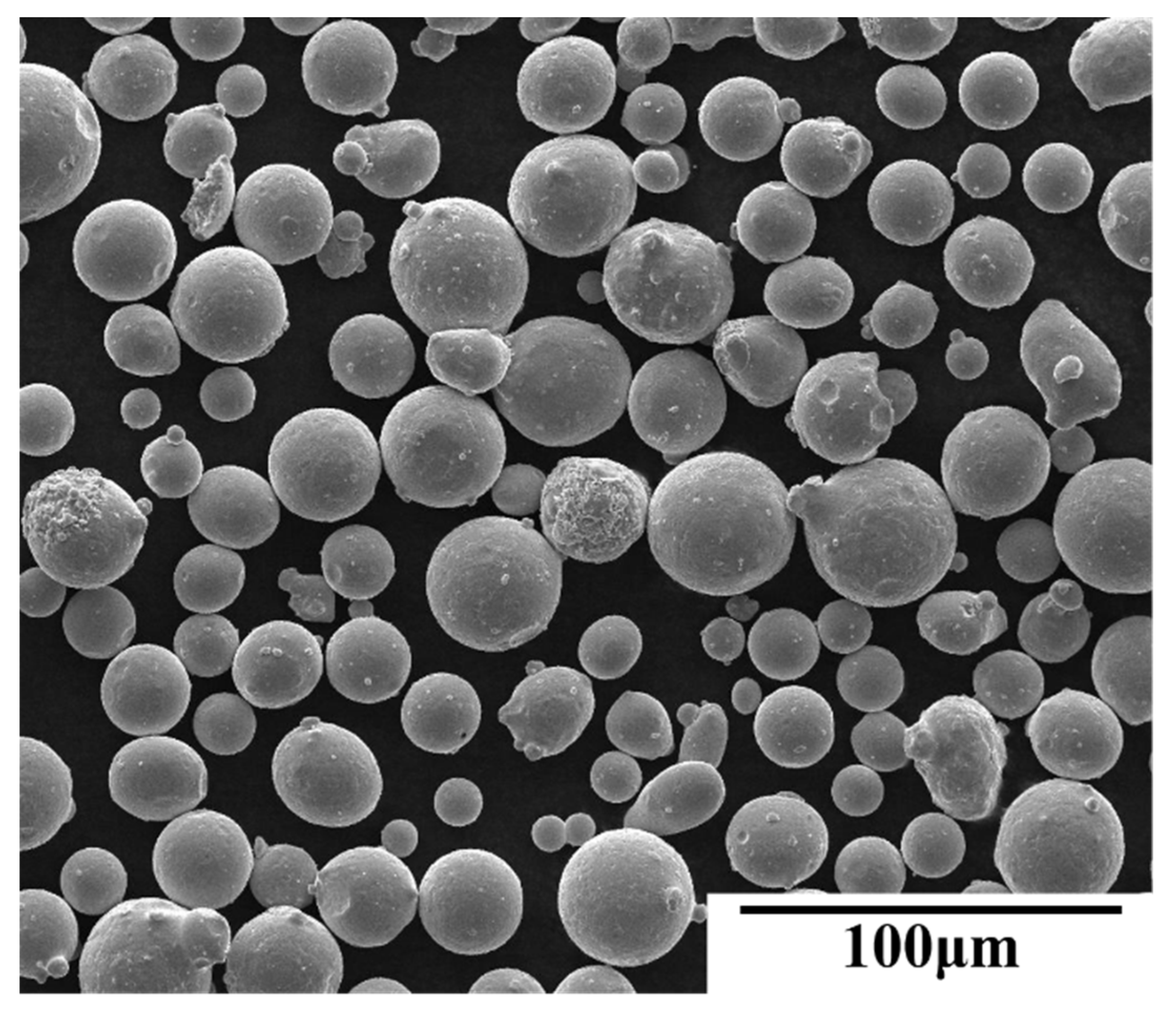
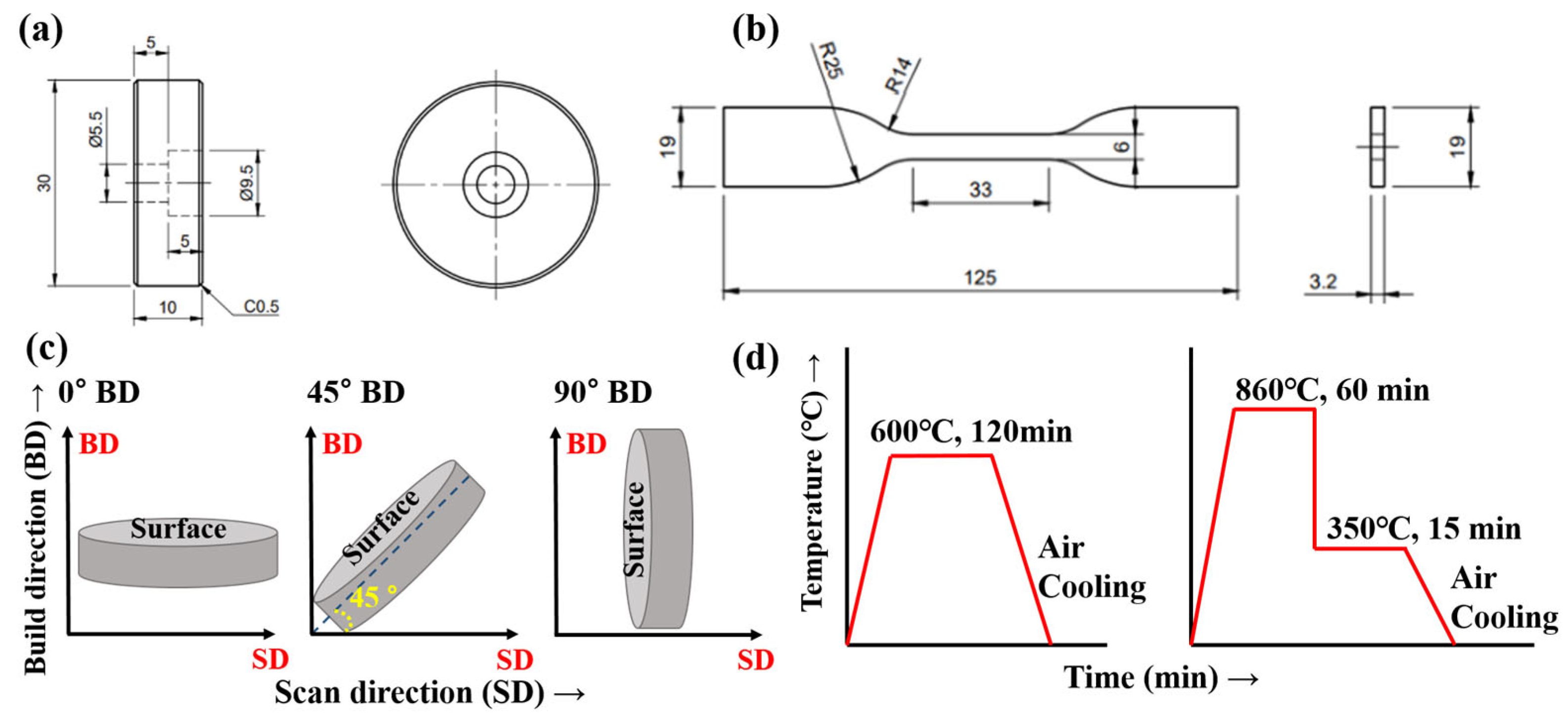
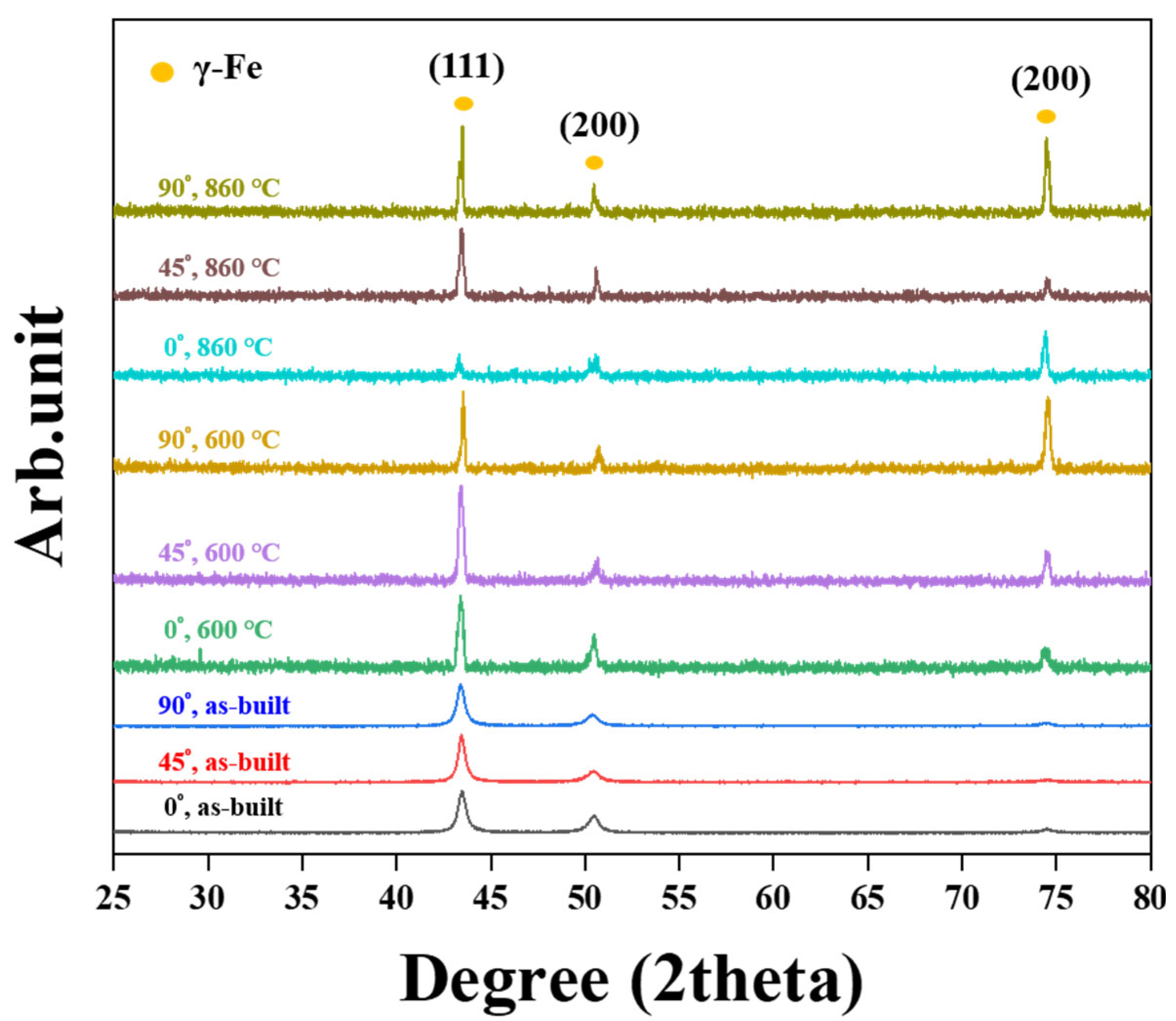
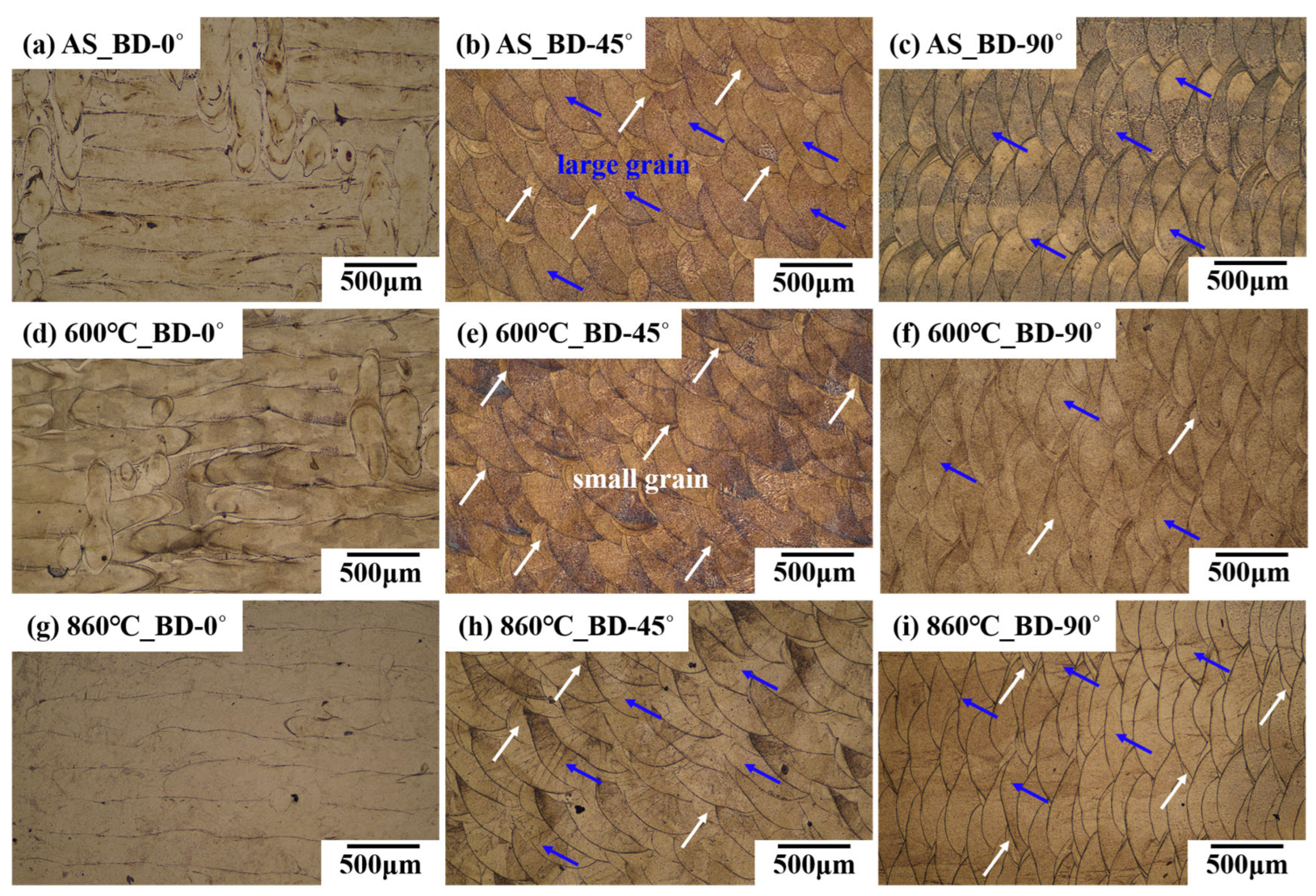
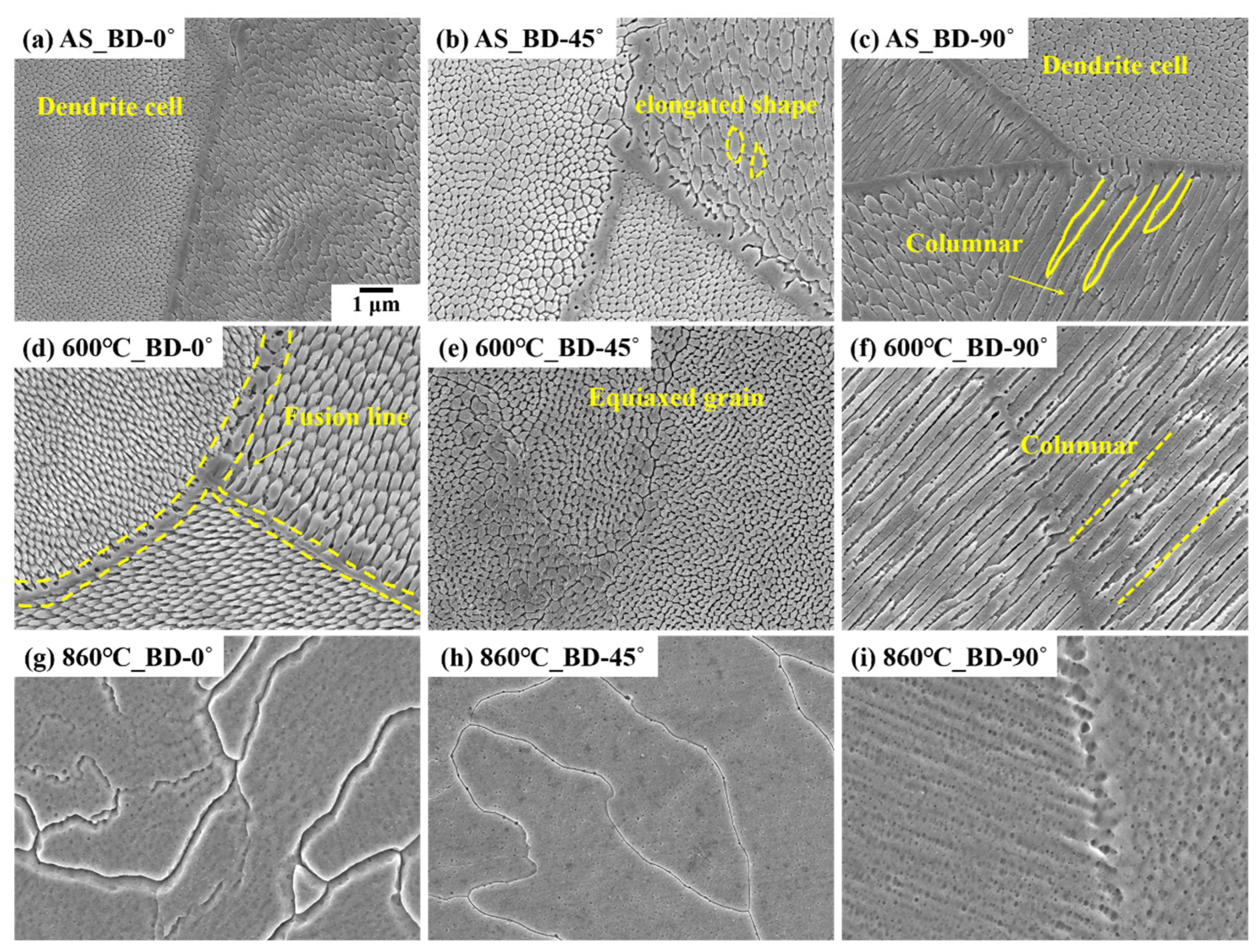
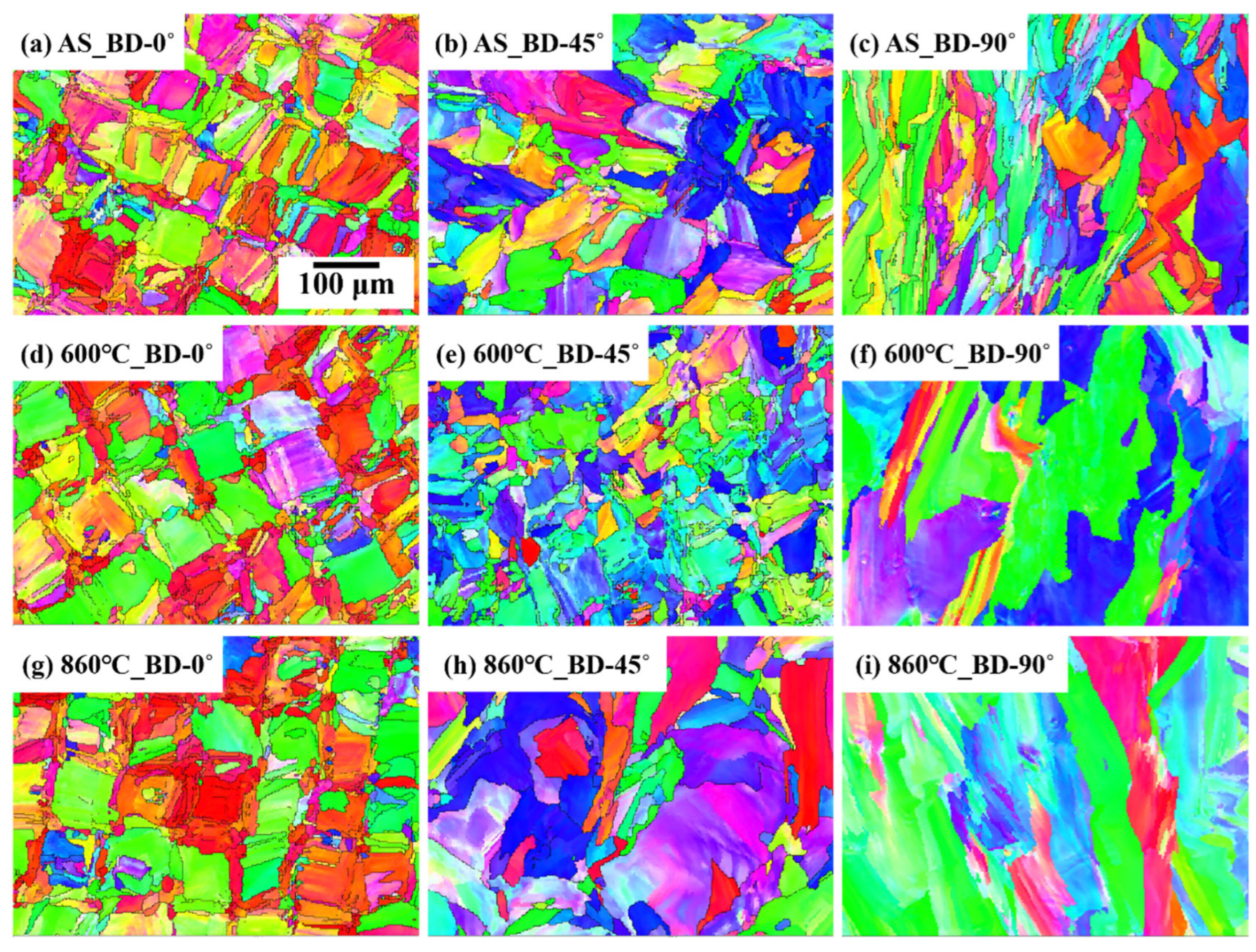
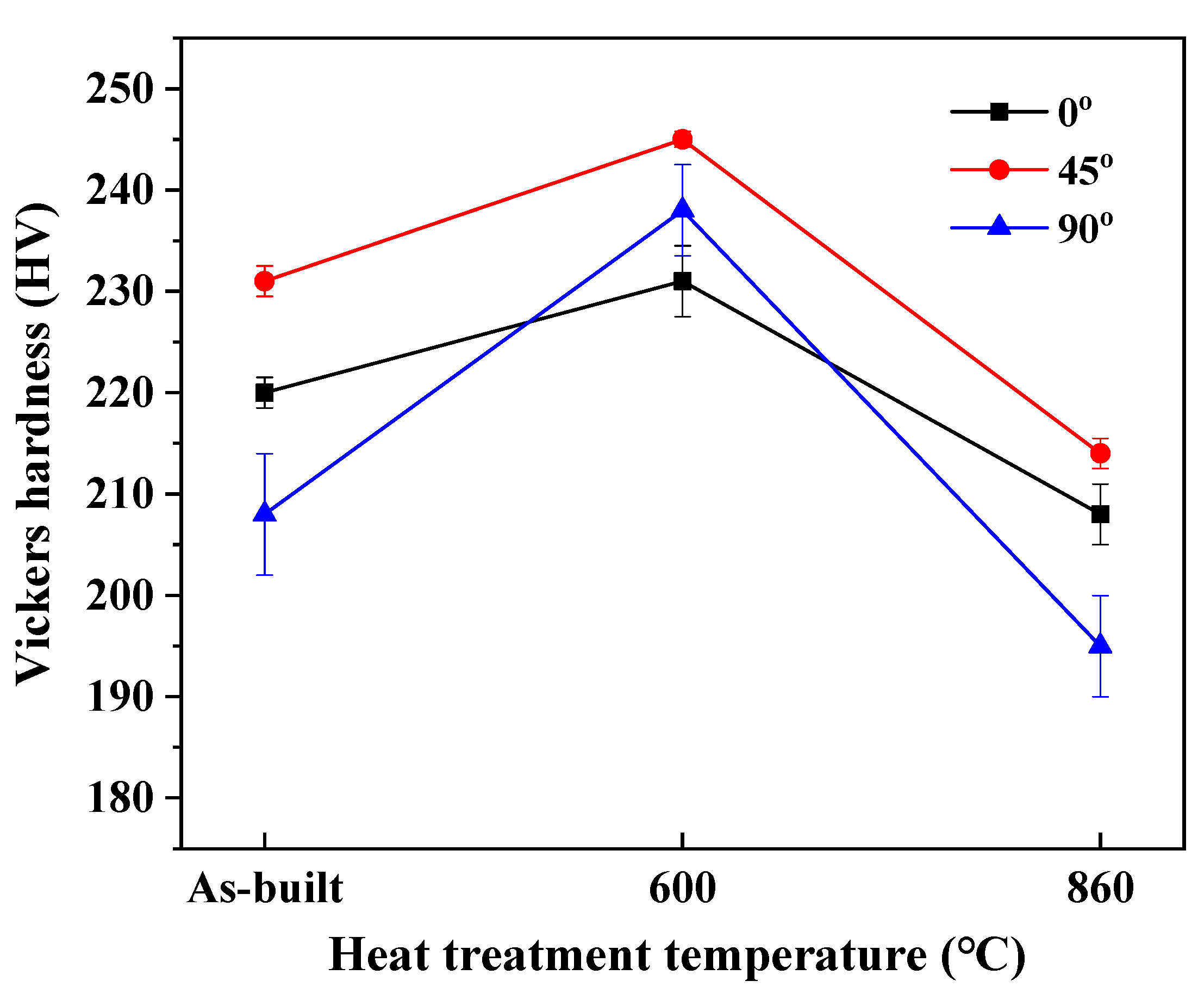

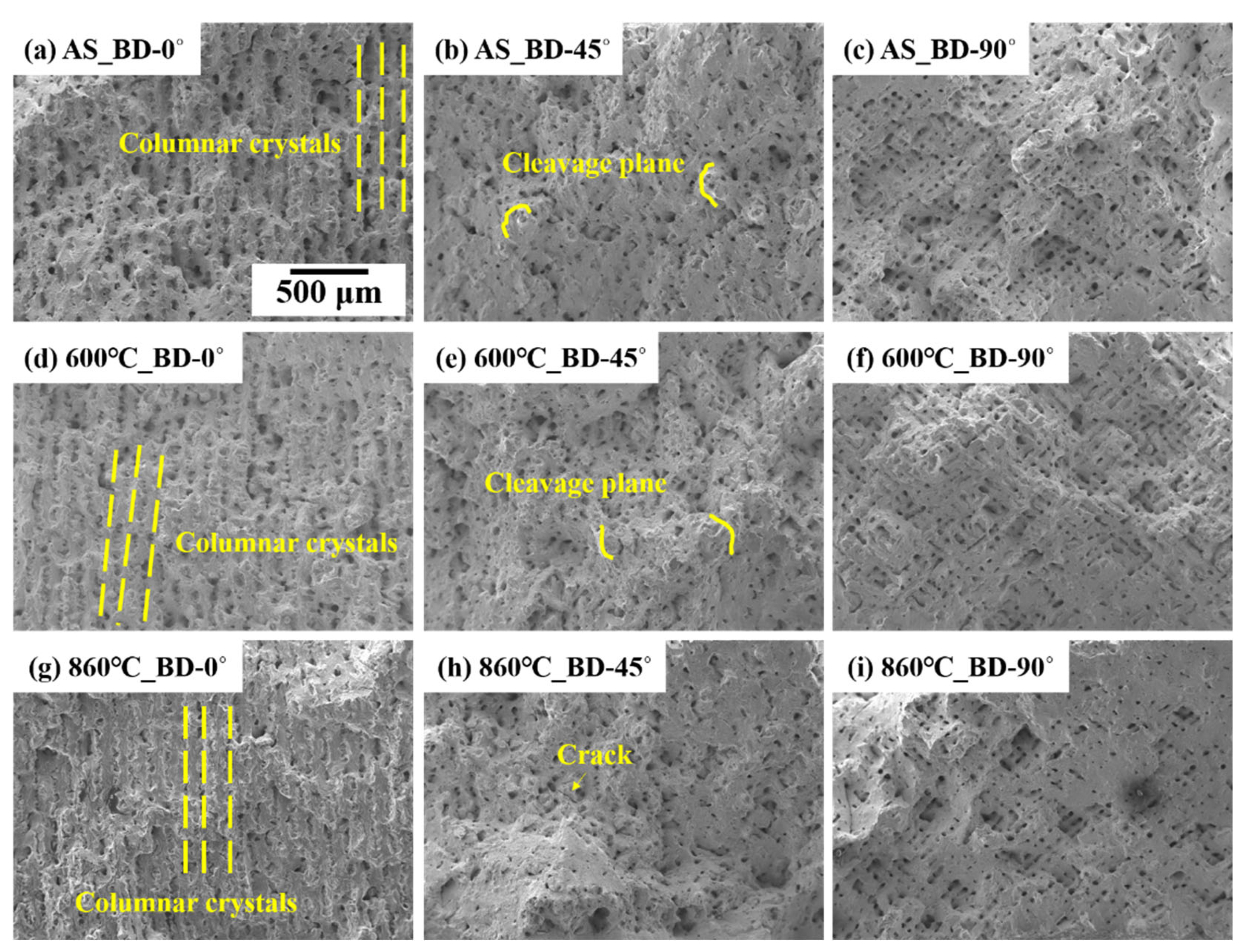


| Element | C | Si | Mn | P | S | N | Cr | Ni | Mo | Fe |
|---|---|---|---|---|---|---|---|---|---|---|
| Wt.% | ≤0.03 | ≤0.75 | ≤2.00 | ≤0.045 | ≤0.03 | ≤0.01 | 16.00–18.00 | 10.00–14.00 | 2.00–3.00 | Balance |
| Heat Treatment, Building Direction | Tensile Strength, MPa | Yield Strength, Kqf | Elongation, % | Grain Count |
|---|---|---|---|---|
| AS_BD-0° | 567 | 1175 | 62.40 | 430 |
| AS_BD-45° | 590 | 1230 | 69.24 | 184 |
| AS_BD-90° | 563 | 1215 | 76.12 | 143 |
| 600 °C_BD-0° | 556 | 1080 | 58.96 | 419 |
| 600 °C_BD-45° | 579 | 1105 | 58.80 | 147 |
| 600 °C_BD-90° | 533 | 1054 | 62.04 | 43 |
| 860 °C_BD-0° | 532 | 922 | 68.24 | 43 |
| 860 °C_BD-45° | 504 | 891 | 65.88 | 372 |
| 860 °C_BD-90° | 505 | 882 | 77.52 | 24 |
Disclaimer/Publisher’s Note: The statements, opinions and data contained in all publications are solely those of the individual author(s) and contributor(s) and not of MDPI and/or the editor(s). MDPI and/or the editor(s) disclaim responsibility for any injury to people or property resulting from any ideas, methods, instructions or products referred to in the content. |
© 2025 by the authors. Licensee MDPI, Basel, Switzerland. This article is an open access article distributed under the terms and conditions of the Creative Commons Attribution (CC BY) license (https://creativecommons.org/licenses/by/4.0/).
Share and Cite
Lim, Y.; Jeon, C.; Lee, Y.-S.; Jo, I. Influence of Build Orientation and Heat Treatment on the Microstructure and Mechanical Properties of SUS316L Fabricated by Selective Laser Melting. Metals 2025, 15, 971. https://doi.org/10.3390/met15090971
Lim Y, Jeon C, Lee Y-S, Jo I. Influence of Build Orientation and Heat Treatment on the Microstructure and Mechanical Properties of SUS316L Fabricated by Selective Laser Melting. Metals. 2025; 15(9):971. https://doi.org/10.3390/met15090971
Chicago/Turabian StyleLim, Yujin, Chami Jeon, Yoon-Seok Lee, and Ilguk Jo. 2025. "Influence of Build Orientation and Heat Treatment on the Microstructure and Mechanical Properties of SUS316L Fabricated by Selective Laser Melting" Metals 15, no. 9: 971. https://doi.org/10.3390/met15090971
APA StyleLim, Y., Jeon, C., Lee, Y.-S., & Jo, I. (2025). Influence of Build Orientation and Heat Treatment on the Microstructure and Mechanical Properties of SUS316L Fabricated by Selective Laser Melting. Metals, 15(9), 971. https://doi.org/10.3390/met15090971






